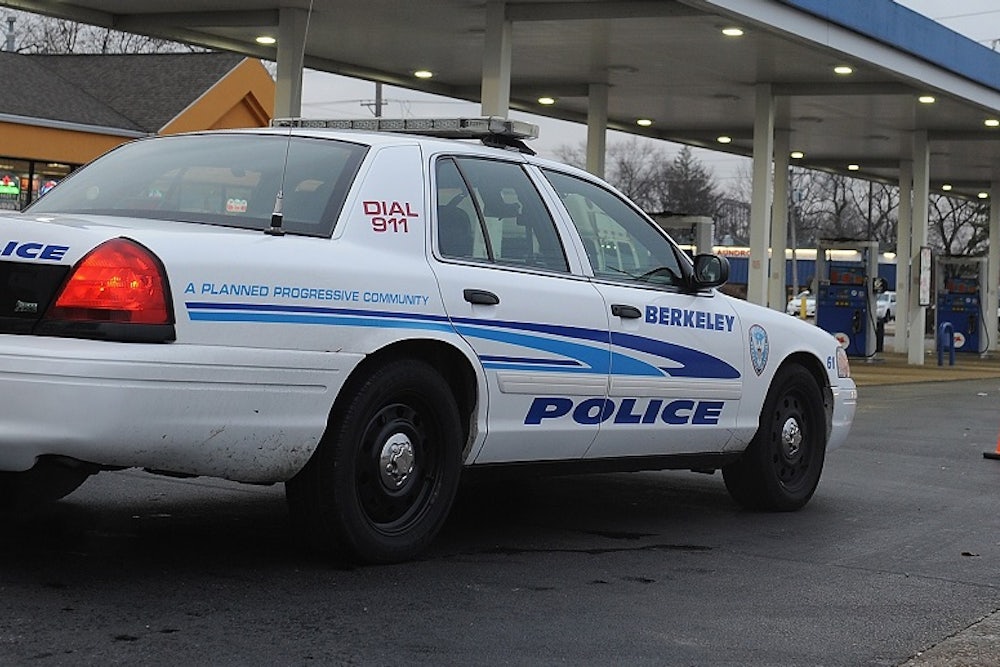On Tuesday night, a white police officer shot and killed 18-year-old Antonio Martin after he allegedly pointed a gun at the officer outside a gas station in Berkeley, Missouri, just a few miles from Ferguson. The incident was captured on a surveillance camera at the gas station, although it’s still tough to see what happened in the video. But there was another camera much closer to the shooting—on the dashboard of the police cruiser, to be exact—that could have provided clearer evidence. However, that camera was off, a reminder that dashboard cams are only part of the solution to ensure greater police accountability.
When dashboard cameras turn on varies by department. In Berkeley, the dash camera turns on when the car's lights are activated, but in Tuesday’s incident, the officer never turned the car’s lights on, so the camera stayed off. It’s not clear if the officer could have manually turned on the camera, but even so, one could understand why he might fail to do so. If the officer arrived at the scene and Martin had already pulled his gun, his first instinct should be to reach for his own gun, not turn on a dashboard camera. It's not clear whether that was the case in Berkeley on Tuesday. If not, the officer should have had time to turn on the camera. Given the automated functioning of the dashboard cameras, though, the officer may have thought the camera was already on. As St. Louis Police Chief Jon Belmar said in a press conference Wednesday, the cops aren't yet used to the new technology.
But should dashboard cameras be on all the time? On one hand, that would certainly provide greater accountability and prevent law enforcement from manipulating the camera to cover up police brutality. If the camera had been on during the incident Tuesday, it would have provided clear evidence of what actually happened —evidence that, if it supported the police's version of events, could calm tensions in Berkeley. On the other hand, it’s an invasion of privacy. Cop cars often travel in public places but also go on private roads and other areas citizens don't consider to be the public sphere. Requiring cops to keep their dashboard cameras on would give the state access to large amounts of video of these private encounters. We may deem that a necessary tradeoff to ensure greater police accountability but it is a tradeoff nonetheless.
The dashboard camera’s automated functioning seems like a relatively smart way to balance the need for greater accountability with the desire to maintain privacy. “When it comes to dashcams,” the American Civil Liberties Union (ACLU) says, “the devices are often configured to record whenever a car's siren or lights are activated, which provides a rough and somewhat (though not entirely) non-discretionary measure of when a police officer is engaged in an encounter that is likely to be a problem.” But that still means the dashboard camera will not always be on in fatal encounters.
Initial reports of the incident in Berkeley suggested that the officer had a body camera on him that was not turned on; those reports now appear to be false. Would a body camera have helped in this situation? Possibly—it certainly couldn’t have hurt. But body cameras come with their own limitations as well. Most importantly, they require officers to remember to turn them on. We certainly don’t want those cameras on in all situations—cops enter homes all the time, for instance. But that discretion creates its own problems. As the ACLU explains, “If the cameras do not record continuously, that would place them under officer control, which would create the danger that they could be manipulated by some officers, undermining their core purpose of detecting police misconduct.” The ACLU supports greater use of body and dash cameras but only with strict protocols. For instance, they want to restrict access to the videos to investigations of misconduct and situations "where the police have reasonable suspicion that a recording contains evidence of a crime."
Cameras are not a cureall. In July, Eric Garner, a 43-year-old black man, was put in a chokehold against police protocol by a cop and died as he repeatedly pleaded, “I can’t breathe.” A nearby bystander captured the incident on tape, but the grand jury still declined to indict the officer despite the video evidence. Although the video did not convince the grand jury to indict, it provoked outrage from the right and left to reform police brutality laws.
Dashboard and body cameras are not necessarily a bad thing, either. It’s always better to have video evidence than not have it. We also need to create specific policies for when those cameras should be turned on and train officers so that they use them accordingly. Tuesday’s incident in Missouri only underscores the complications of that task.
